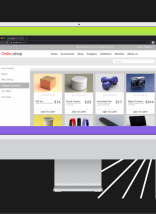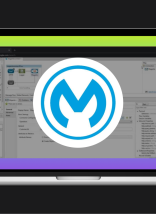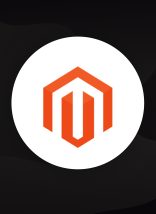Choosing an eCommerce platform can be difficult. There are many options available, each with different benefits designed to best help you. While some businesses prefer a SaaS solution (like Shopify), others prefer custom eCommerce options.
How do you make sense of it all? How do you pick the best eCommerce platform for your business?
There are two directions you can take when selecting a platform. Do you want hosted or open software? Let’s go ahead and assume no one wants a proprietary system that you couldn’t change on a whim. Although, there are sure to be some out there. Technology loves to evolve in mere seconds.
Hosted eCommerce Platforms (SaaS)
A hosted solution is an eCommerce service that you sign up for. You then build your store within an online system. This is like other web-based software, such as Salesforce or Google Docs.
The benefit of a hosted eCommerce solution is its ease of use. Setting up and getting started is a breeze. You still have to put effort into learning how to use the system and customize it as you’d like. But, the technical hurdles are much lower than installing and designing software.
There are some downsides to this solution. At some point, you will hit a roadblock in the system. It won’t be able to handle something specific. Since the source code isn’t accessible, changing the system is costly.
Then you’re stuck with a difficult choice. Do you learn to live without the specific feature you wanted? Or do you switch platforms all together?
Switching platforms is very complicated. For starters, it requires a time investment. You’ve also already established search positioning. You have become familiar with your customers and how to best serve them by using this system. Moving your store to a new platform becomes a very, very disruptive process. In extreme cases, the results can be catastrophic. We often see this happen when the move is not planned the way it should be, or a good consultant/developer isn’t used.
Some of the most popular hosted eCommerce solutions include:
- BigCommerce
- Shopify
- Magento
- PinnacleCart
eCommerce Software
Software based approaches to eCommerce also come in two dominant styles. There is custom software built from the ground up (also called proprietary software). There are also off-the-shelf systems that you can customize.
Custom eCommerce systems used to be the norm. Off-the-shelf offerings lacked strong development and did not have helpful features available. However, the offerings have evolved over the years. It’s now rare to see a custom system in place. Well, unless you’ve got less than a 20% overlap between your needs and the best-fitting off-the-shelf option. Another scenario would be a high-security application. Perhaps it’s not permissible to use a system with source code available to the public due to company policy.
Paring Down the Options
There are hundreds of eCommerce platforms available in every language. Ruby, PHP, .NET, and even Perl/CGI are out there, waiting to assist you. What’s next?
The best way to start is to figure out if you or your developers have a technology preference. Making this decision first will whittle down dozens of choices. Now your list of possibilities is more manageable.
Now, look at which of the remaining platforms is most used. The more momentum a system has, the more popular it will be. The more popular it is, the more developers there are who will support it, and the longer its life will be. Even after the development of a stronger platform, popular systems maintain their status. They continue to have the most add-ons, extensions, plugins, support, and available developers.
Not every solution will have the same community support as Magento. But, Magento will give you a good benchmark for what’s possible. It’s used by over 200,000 organizations and that number continues to grow. There are over 500 extensions available.
Look at the functionality of the platform and any extensions they might have. See how close you can get to what you need without custom development. This will save you time and money. The more active the extension marketplace is for a product, the better.
Check out the demo of the software, too. One should be available for both the customer area and admin. Customer areas tend to be similar, but admin areas can vary a great deal.
Log in and walk through standard tasks. Work through adding/editing a product and processing an order. See what it is like to view reports and segment customers. You’ll be living inside this system for a while, so make sure it’s easy-to-use and satisfactory.
Making the Final eCommerce Platform Decision
Marketing is important when you’re selling online. First, look at how well the platform is set up for organic rankings. Check things like the friendliness of product URLs.
How clean is the source code? See how well customer sites rank for product-specific terms. You can always enhance your site’s ability to rank well. But, the better the tools are out of the box, the further ahead you’ll be.
Check out the biggest sites who use each platform. This might take some digging. Many platforms, though, will proudly list their banner customers. For example, Magento won’t hide the fact that they work with Vizio, Nike, and North Face, to name a few.
Look at reviews and locate forums for a particular product. Jump into the forums and look for problems, complaints, and reviews. Every product will have some technical issues and people grumbling about them. Try to get a feel for the vibe of the community. Take note of whether the company is responding to complaints, issues, and suggestions. If the company doesn’t offer a user forum, that’s usually a red flag.
Your Platform Is Up to You
With this approach, you should be able to narrow down your options from hundreds to just a few pretty quickly. Do your homework. Transferring to a new platform later is disruptive. Whatever direction you decide to go in, be confident in your choice.
If you choose something successful and mainstream, you won’t break your business. From our experience, things like marketing, customer service, merchandising, descriptions and photos, prompt delivery, finding a niche, and creating loyal customers deserve much more of your attention.
If you’re still not sure where to go next, we can help you avoid resorting to the flip of a coin.










